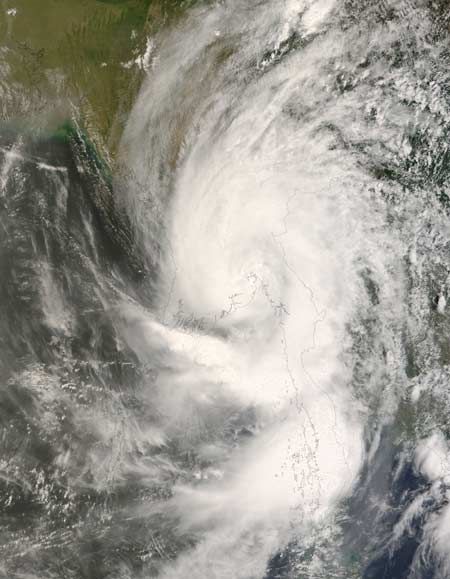
Tropical Cyclone Birth Predicted with Supercomputer

It's the heart of hurricane season in the Atlantic Ocean and Gulf of Mexico, the ripest time for tropical cyclones to develop over these waters. But predicting whether or not a storm system will grow into a hurricane is difficult.
A new supercomputer model has taken a leap forward in this effort though, reproducing and predicting the birth of an Indian Ocean typhoon (also called a hurricane or cyclone) five days before it became a fully formed storm.
Cyclone Nargis, as it was named, hit the country of Myanmar on May 2, 2008, with its more than 105-mph (165-kph) winds and powerful storm surge killing more than 100,000 people in the Southeast Asian country — one of the 10 deadliest cyclones on record.
To save lives from the high winds, flooding and storm surges of tropical cyclones, forecasters need to give as much advance warning as possible and the greatest degree of accuracy about when and where a storm will occur, scientists say.
Bo-wen Shen of the University of Maryland used NASA's Pleiades supercomputer and atmospheric data to simulate the birth of Nargis in the warm Bay of Bengal waters. (Tropical storms get their start from warm water evaporating off the surface of bodies of water.) This effort could help scientists better understand how to predict the formation of these killer storms particularly in this region, where the meteorology and monitoring of cyclones is hampered by a lack of data.
"To do hurricane forecasting, what's really needed is a model that can represent the initial weather conditions – air movements and temperatures, and precipitation – and simulate how they evolve and interact globally and locally to set a cyclone in motion," Shen said.
The boosted "brain power" of the supercomputer allowed scientists to run improved simulations of storms with more fine-scale data, which allows for more accurate and fine-tuned predictions.
Sign up for the Live Science daily newsletter now
Get the world’s most fascinating discoveries delivered straight to your inbox.
After running the simulation, Shen and his colleagues could compare what the model predicted would happen with the storm to the actual observations of Nargis. They found that the simulation was able to predict the birth of the storm five days before it formed. [See the model's predictions in this video.]
While the results are encouraging, this one study isn't enough to prove the overall accuracy of the model.
"Shen's model worked for one cyclone, but it doesn't mean it'll work in real-time for future storms," said study co-author Robert Atlas, director of the National Oceanic and Atmospheric Administration's (NOAA) Atlantic Oceanographic and Meteorological Laboratory in Miami, Fla. "The research model Shen and predecessors at NASA have developed sets the stage for NOAA's researchers to hone and test the new capability with their own models."
- Images: Hurricanes from Above
- How Do Cyclones, Hurricanes and Typhoons Differ?
- 2010 Hurricane Forecast: Active Year
This article was provided by OurAmazingPlanet, a sister site to LiveScience.












